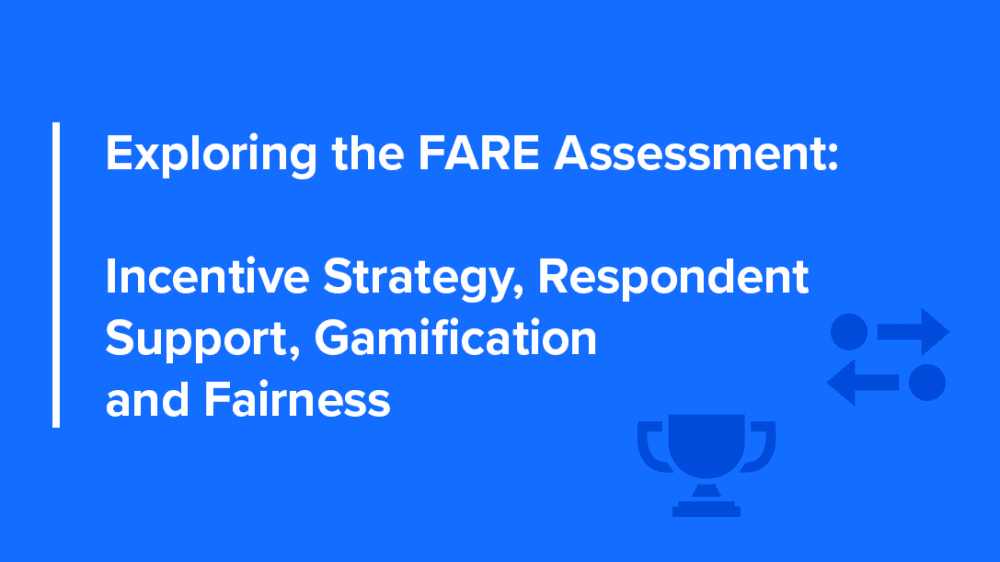The market research industry is facing its biggest change in 20 years. AI-driven interviews and in-depth discussions are replacing simple surveys. But there’s a problem: participation incentives are stuck in the past. While companies ask for deeper insights and thoughtful responses, they’re still using reward strategies designed for quick, simple tasks.
The FARE Framework helps companies modernize their approach to participant engagement. This article examines four key elements that need updating for modern research: incentive strategy, proportionality, participant support, and gamification.
Match participation incentives to research goals
Research requires different types of participant engagement. Companies now ask participants to record videos of their shopping trips, join month-long discussion groups, or share deep insights about business trends. Yet, their reward programs still treat every task the same way.
“Most companies have a one-size-fits-all incentive approach. They have one set of offers, maybe Amazon cards and PayPal, and they do that no matter what type of activity they’re trying to encourage,”
explains Frank Kelly, Market Research Practice Lead at Virtual Incentives.
The reward should be aligned with what behavior you’re seeking to motivate. For instance, different research methods need different reward strategies. Purchase diaries need small, frequent rewards to encourage regular updates. Discussion forums work better with milestone bonuses that reward active participation. High-level business interviews need premium rewards that reflect participants’ expertise.
Incentives should also be aligned with timing. Research incentives generally fall into two key timing categories: short-term and long-term engagement. Short-term incentives, like quick bonuses for referrals or data access, work best for one-time tasks. Long-term strategies focus on building community, using progressive rewards that accumulate toward larger goals. These staged rewards are particularly effective for ongoing research communities, where participant retention is crucial.
Another thing to consider is the fact that rewards don’t always have to be monetary. Companies can also tap into intrinsic motivation. This is particularly effective in public opinion polling, where participants are driven by the desire to have their voice heard and contribute to positive change. Some organizations successfully combine this approach with charitable incentives, allowing participants to contribute to community improvement through their research participation.
Fair compensation keeps participants engaged
Research tasks are becoming more complex, but many companies still use basic reward models. Current participation incentives fail to reflect modern research demands. For instance, a participant who spends 20 minutes answering a survey with complex grids and detailed open end questions often earns the same as someone who answers a simple multiple choice survey.
This imbalance undervalues participants’ time and discourages those who provide in-depth responses. Companies need better ways to measure how complex their tasks are so they can pay people fairly.
One concerning practice affects participants who don’t qualify for surveys. Late disqualifications are mostly due to poor survey design which can be avoided. Participants might spend 15 minutes answering questions before learning they don’t qualify. However, many companies offer no compensation for this time, treating participant effort as worthless unless they complete the full survey. This approach drives away quality participants, especially those with expertise who value their time.
Some companies still use outdated cost-saving tactics like sweepstakes instead of guaranteed payment. Others delay payment for weeks when modern systems allow immediate rewards. These practices damage trust and drive away participants who expect modern efficiency. To keep quality participants engaged, companies must ensure their rewards match the time, effort, and expertise required for each task.
Companies that align rewards with participant value create better research experiences for everyone. By ensuring fair compensation for time, effort, and expertise, organizations can build lasting partnerships with engaged participants.
Good support builds trust
Research platforms need strong support teams. As surveys get more complex and use new technology, participants need help with both survey questions and tech problems. Many companies are too slow to respond or give unhelpful answers.
“What’s tricky is that as more technology is being employed, the real question becomes: is tech support separate from general research support? Some companies say ‘Oh, you’re having problems with the app? Don’t talk to this help desk, talk to that help desk.’ You’re sent to some other company’s help desk, and who’s managing that?” Frank explains.
The best platforms help participants quickly through email, chat, or phone. They can assist in different languages and with various tech issues. Most importantly, they solve problems directly instead of sending people in circles between different support teams.
Modern support systems leverage AI translation tools to provide assistance in over 100 languages, enabling quick response times regardless of location. However, the human element remains crucial—automated systems should complement, not replace, personal support.
Making participation incentives engaging
Traditional surveys often fail to engage participants, but game-like elements can enhance the research experience through strategic rewards and interactive features.
Gamification elements resonate particularly well with younger participants (ages 18-29), who have grown up with digital experiences. Mystery boxes, bonus points for quality responses, and interactive feedback mechanisms can significantly boost engagement among this demographic.
Research platforms can also improve engagement by adding progress tracking, quality bonuses, and achievement badges. When participants receive feedback about the quality of their work, response quality improves. Interactive features and surprise incentives transform data collection from a repetitive task into an engaging experience that benefits both participants and researchers.
Building better research experiences
Research methods will continue to evolve. While AI chats and video feedback have made research more efficient, it has created new challenges for participant engagement. The FARE framework helps companies modernize their participation incentives through better rewards, fair pay, solid support, and engaging features.
Companies making these changes see higher-quality responses and deeper insights. Success depends on strategic incentives that match research goals, fair compensation that values contribution, reliable support that builds trust, and engaging experiences that maintain participation.
